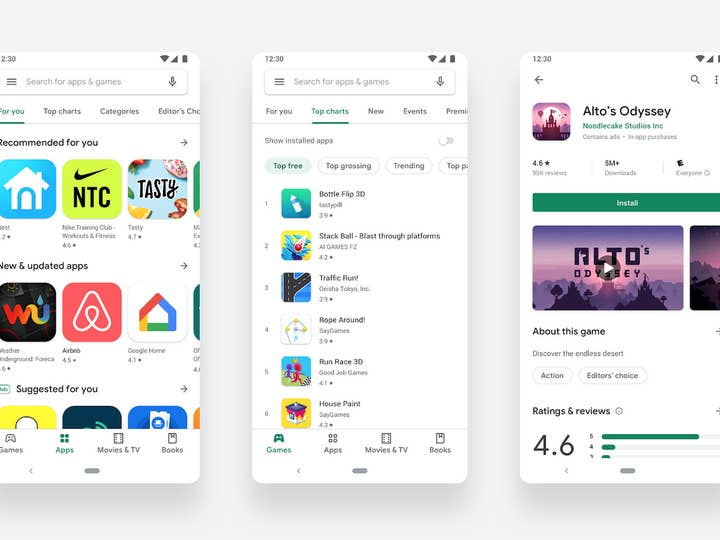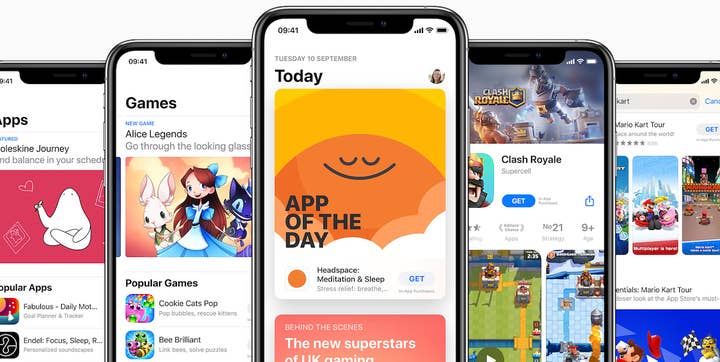A beginner's guide to mobile distribution
GameBake's Michael Hudson explains how to approach your development and distribution journey on mobile
The journey of developing games is one filled with ups, downs and a whole lot of lessons. Most of these lessons will come from what, at the time, feels like failure. This may sound tough, but the hope is that it leads to the eventual success you've been working so hard for.
I speak as someone who has been making games for well over a decade, opened a studio, closed a studio, and co-founded a mobile games distribution platform. I can say from personal experience that the graft to make that hard work pay off will be one of the most rewarding experiences that you will have.
What I want to talk about are some of the lessons I've learned over the years which will hopefully offer some pointers on how you can approach your development and distribution journey through the wild west also known as the games industry!
Start as you mean to go on
I'm going to kick off at the very beginning, which is deciding what you actually want to achieve. Of course, you want to develop an amazing game for millions to enjoy. But is this the end goal, or do you want to build up your own studio and brand in the market? Do you enjoy the process of growing a business and want to focus your time on relationship-building? All of these are important questions that you should think about before you start your journey.
Understanding not only the direction you're heading, but the destination coordinates will allow you to find what you excel in and focus intently on it
You might think this is getting ahead of yourself, but it's this strategic thinking that will guide you towards success. Understanding not only the direction you're heading, but the destination coordinates will allow you to find what you excel in and focus intently on it.
Trust me when I say having a plan and a focus from the start is important. I've been on the other side -- trying to create games that magically turn into smash hits -- and it's more likely to lead to grey hairs than to success.
Identify your business model
The games industry is a business, after all. So how do you want to monetise your game and how does this impact your distribution options?
Mobile game monetisation is arguably in its most significant ever transition period. With similar measures to Apple's privacy-led changes on iOS14 also expected on Android soon, finding and acquiring users for our games is more difficult than ever.
Nevertheless, most of us will continue to use the tried and trusted free-to-play model. But it's your responsibility to decide on the ad formats and content you are happy with.

Are you happy to run playables for competitor games? If your IP is targeted towards children, are ads for alcohol and tobacco (and potentially sugary treats) going to be well-received? Being associated with highly interruptive ad formats or undesirable brands could limit your monetisation of your game in certain markets that your game could have had great success in -- or even lead to a blanket ban. Likewise, premium brands that are concerned with brand safety won't give your game a second look.
The direct sale of games to consumers is prohibited without the correct licenses in markets such as China, while monetising solely with in-app purchases requires great scale, granular knowledge of user behaviour and content that fits both your game and the expectations of each market.
So, again, ads may be the simplest and most profitable way to avoid monetisation hurdles when considering the time and cost of license approvals. China is not the only market with hurdles here -- other countries even have tax withholding laws that require government certification in order to claim your game's revenue.
Find a publisher (or don't)
It's difficult to draw a firm dividing line between publishing and distribution. Some publishers will offer end-to-end support while others will plug in distribution experts to fill gaps in their knowledge and leverage relationships that they don't hold themselves. Then there's self-publishing.
I'll be frank, self-publishing is risky, especially for those just starting out. In my experience, getting your game in front of users is going to be your biggest challenge and is why many look to a seasoned publisher for support. However, it's by no means an impossibility. Just look at the huge success of games such as Among Us which is just one recent hit that proves small, talented teams can build games that knock big players in the market to one side on their rise to the top (and provide the, um, inspiration, for a major new Fortnite game mode).
If you want to self-publish, an amazing game is rarely enough
If you want to self-publish, however, an amazing game is rarely enough. You need a highly entrepreneurial mindset and strong team with varied experience that includes development, testing and marketing -- and the ability to identify partners for services such as localisation if necessary. That's why most will opt for a publisher, many of which have their own areas of expertise in terms of specific stores or game genres. What they all have in common is resources to help you improve your game, test your game and eventually market your game to the users that you want to reach.
Publishers are here to help but they are also in the business of making money, so expect to give up some control of decision-making and to receive constructive criticism and feedback. Be flexible and expect to be asked to make changes because, at the end of the day, your game needs to make revenue that powers it to scale to millions of players.
Whether you are self-publishing or working with a publisher, there is one thing you should be thinking intently about in 2021 and that is how to make your game available across multiple platforms.

Don't be afraid of being 'alternative'
Distributing your games, whether you are working with a publisher or not, normally centres around a few major platforms; on mobile we're talking about the Apple AppStore and Google Play store. But there is a wealth of opportunities out there and many other platforms have millions of users just waiting for great games to play. Unfortunately, due to lack of awareness and expert knowledge, most of these platforms and opportunities never get a second look, which is why the industry still refers to them as 'alternative'.
The Apple App Store and Google Play have millions of games between them and the low barriers to entry and familiarity of these platforms make them the go-to for most of us. But, with thousands more games added daily, discoverability is a major issue.
[Alternative] platforms are actively seeking to attract games to meet user demand and they provide the opportunity to shine with much lower marketing costs
Now I'm by no means saying don't publish on these two platforms first or at all; what I'm saying is they are highly competitive. The chance of succeeding without a publisher is minimal and even with a publisher it is still extremely difficult to break through. So I'd always suggest complementing your strategy for the two core stores by thinking about the many amazing platforms beyond them.
Huawei AppGallery has over 700 million monthly active users globally, with Samsung, Xiaomi, OPPO and many more not far off these numbers with their respective stores. And what do all these stores have in common... Lack of content! These platforms are actively seeking to attract great games to meet user demand, and they provide the opportunity to shine in front of millions of engaged users with much lower marketing costs and overall effort -- if you play your cards right.
What's the catch? While the opportunities are huge, the barriers to entry tend to be higher than Apple and Google in terms of technical integration and making sure your game's content is considered interesting and suitable across markets.
However, if you plan your development, if you think about your technology and stay organised, then you should be able to integrate each platform's relevant technologies and offer your game to potentially hundreds of millions of users. Likewise, by developing games that can be localised or even better, require minimal localisation, you can make sure a wide range of options are available.
Networking is key too. In markets such as China, if you or your publisher has built a relationship with a major local player such as ByteDance or Tencent, this can be a huge bonus. The same can be said of companies such as Cafe Bazaar which can help you reach middle-eastern markets such as Iran.

Remember the web, and be social
Mobile app stores are of course the biggest platform type, but they're not the only way to target mobile users. Despite growing up secretly playing Miniclip in IT lessons, many of us forget that web gaming is where many of the modern trends we see on mobile have their roots. With today's browsers and modern web technologies, it is possible to bypass the app stores entirely and launch a game on mobile via a browser.
Although not the most common way to bring a game to market, it is a potential route to billions of mobile users with the right marketing strategy. There are some downsides of course, mobile data restrictions and speeds being one of the biggest concerns before the 5G rollout truly gathers steam worldwide, but this is nothing that can't be solved with a great developer or team behind that next big hit.
Beware, sometimes even great devs don't realise their game's tech affects the platforms they can target. It's better to decide this for yourself rather than letting your game make the choice for you.
With today's browsers and modern web technologies, it is possible to bypass the app stores entirely and launch a game on mobile via browser
For example, if you want to distribute your game on web or social platforms then you need to be looking into web technologies and frameworks such as HTML5 that will allow you to build games optimised for these platforms, something such as Phaser, BabylonJS or Playcanvas. Different technologies will open different doors and understanding what doors you want to walk through is going to guide your game development journey.
We can't talk about being social without mentioning the most social platforms of all. I'm talking Facebook, Snap, WeChat, VK and many more. Most of these big social platforms now have varying forms of instant gaming which allows users to play your games directly within their favourite social platform. The benefits are clear, with their entire friends lists and hundreds of millions more users ready to pick up and play the game with them -- without downloads.
These platforms offer amazing opportunities to scale, but they suffer from poor retention and therefore a smart approach needs to be taken when targeting them. Just uploading a game won't be enough, you need to think about how the game works within the context of the platform it is being played on. How will users share the game and invite their friends? How will they interact and play with others? Is it easy to discover the game, and find it again for next time?
There is a lot to think about when debating if web or social platforms are for you and for your game, but, it is worth thinking about as done correctly, the opportunity is huge.
Protect your IP
Whether you are working with a publisher or going it alone, you need to do your best to protect your IP. It's your baby, after all, and wanting players to experience the best of the game you put days of your life into is only natural.
What's the best way to achieve this, when even huge publishers such EA and CD Projekt Red have been hacked in 2021? Frankly, it's hard to stop hackers from cracking your mobile game and distributing it upon platforms that you're not live on -- or block nefarious 'developers' from cloning your game entirely to try and benefit from the hard work and success that you are having.
In my experience the most effective way to protect your IP is to be proactive with its distribution and build brand recognition that resonates with players. Getting your game live on as many high-quality platforms as possible has the dual effect of ensuring demand for your game is being met with the real thing, and also means you can then work directly with those platforms to stop hacked or directly cloned versions of your game from going live. If issues do arise, you of course can go the legal route and this is likely to be successful. It's also likely to be a slow and expensive process.
Platforms need content for their business model to succeed. They of course want the real, legit IP, not knock-offs. However, if you aren't bringing them your game, some will settle for the next best thing, which means lost users and lost revenue for your game. So protect your game and your hard work by distributing and scaling your game to be visible and available globally. Ultimately, scaling your game and the revenue it generates is the proactive approach to IP protection.
Keep questioning what you think you know! The last point here circles back to the very beginning: to start as you mean to go on. With a good plan in place from the very start of your development journey, you can avoid many mistakes that may hurt your game as you have already decided the direction you want to head and understanding this, following your plan and executing upon it is what will drive your success.
What's that old saying? Even the best laid plans... It's definitely always important to build in some flexibility too. The reality of the games industry is that antitrust laws in the United States, government u-turns in China and huge changes to advertising by the likes of Apple and Facebook can alter how we distribute and monetise our IP overnight. Who'd be a game dev, eh?
Michael Hudson is CEO and co-founder of global games distribution platform GameBake. With over 15 years of experience in the industry, he drives GameBake's vision and operations, and builds relationships with mobile game publishers, app stores and advertisers.
